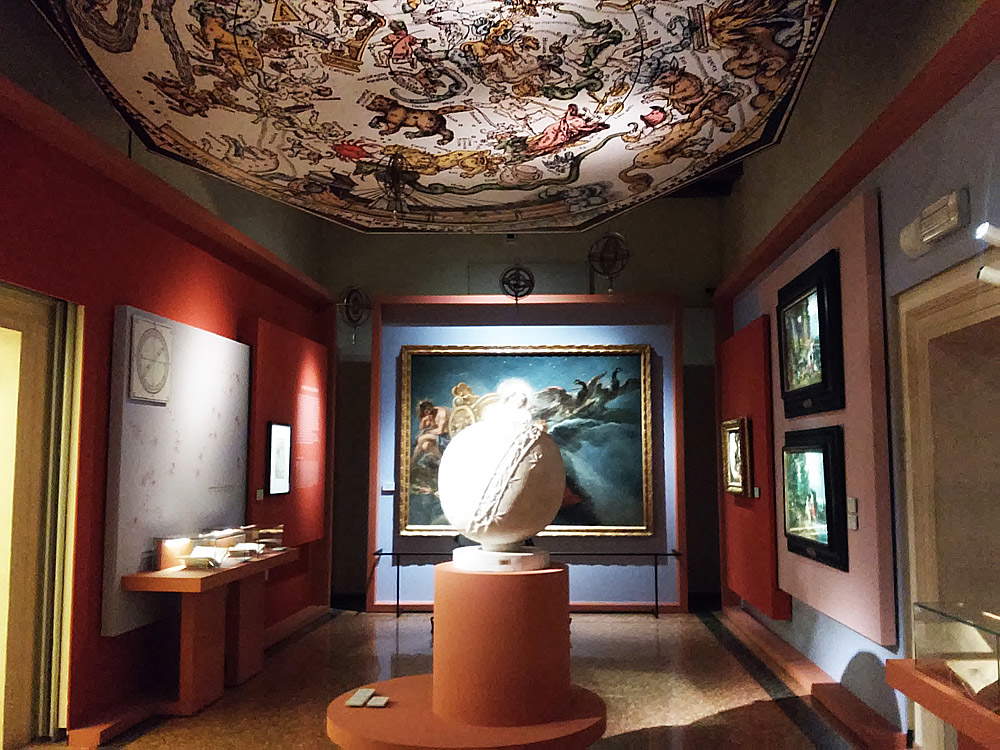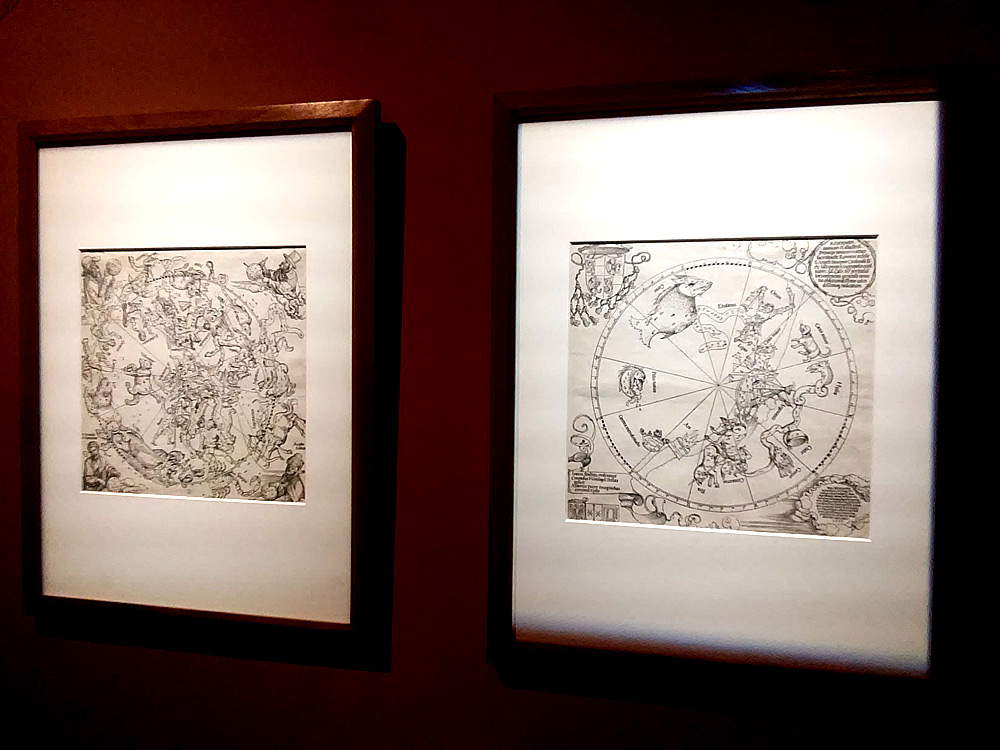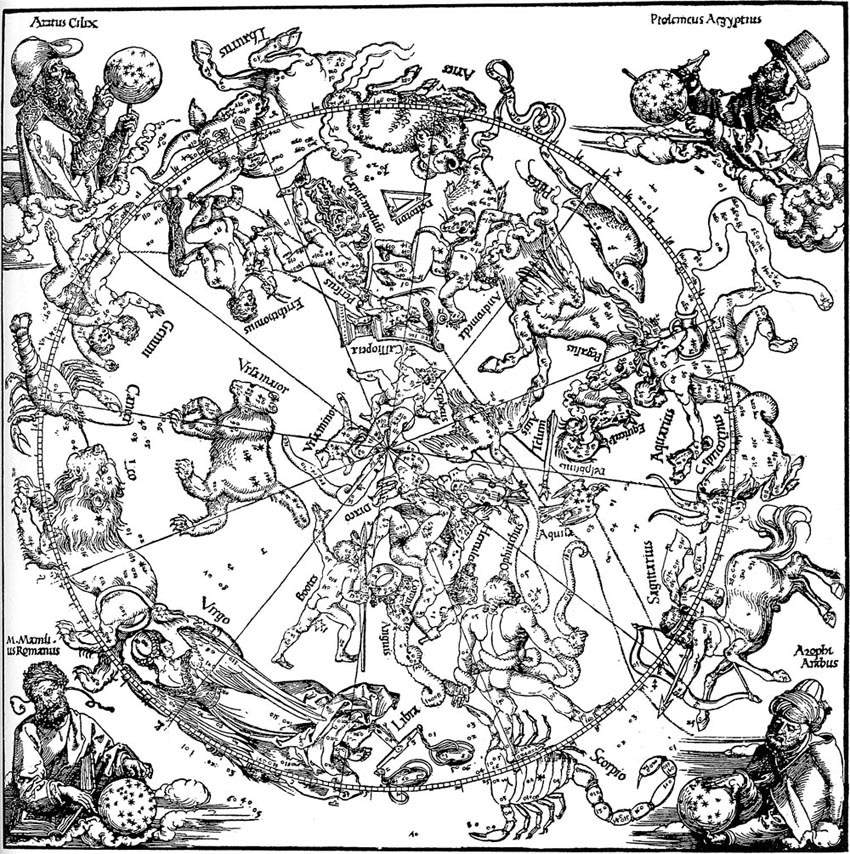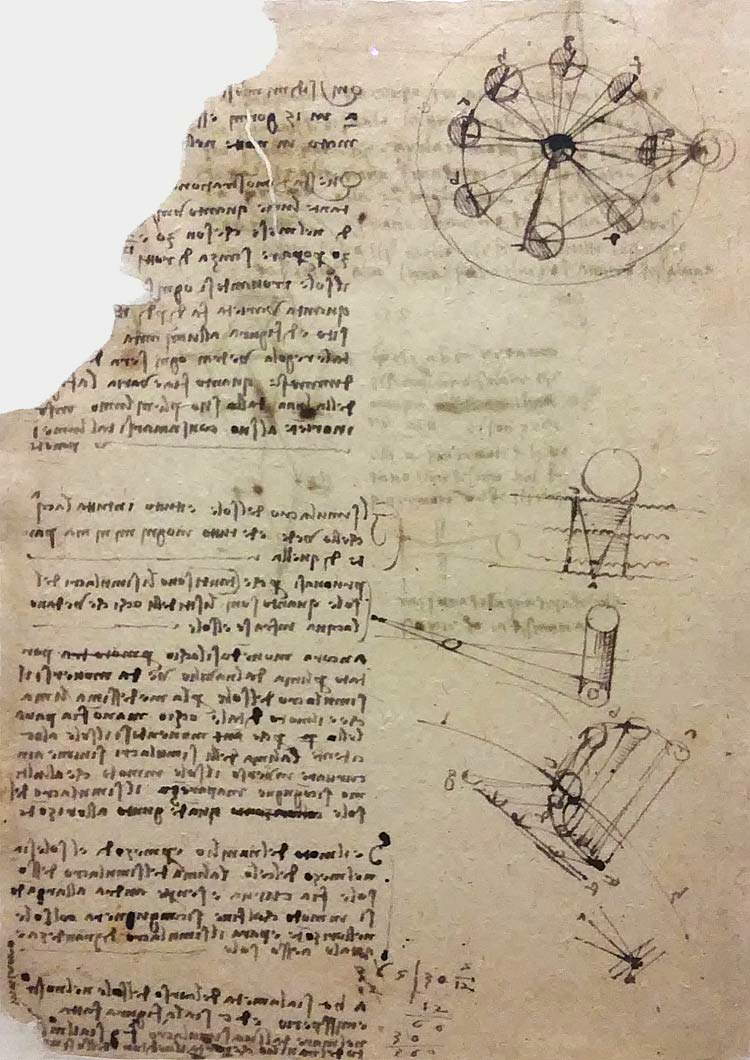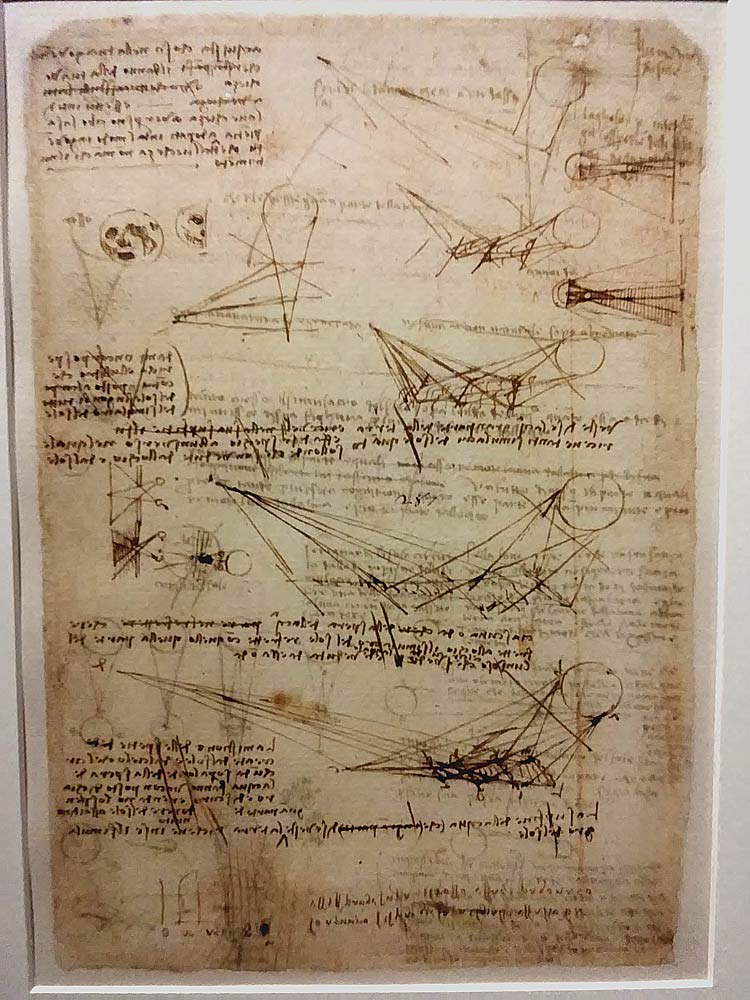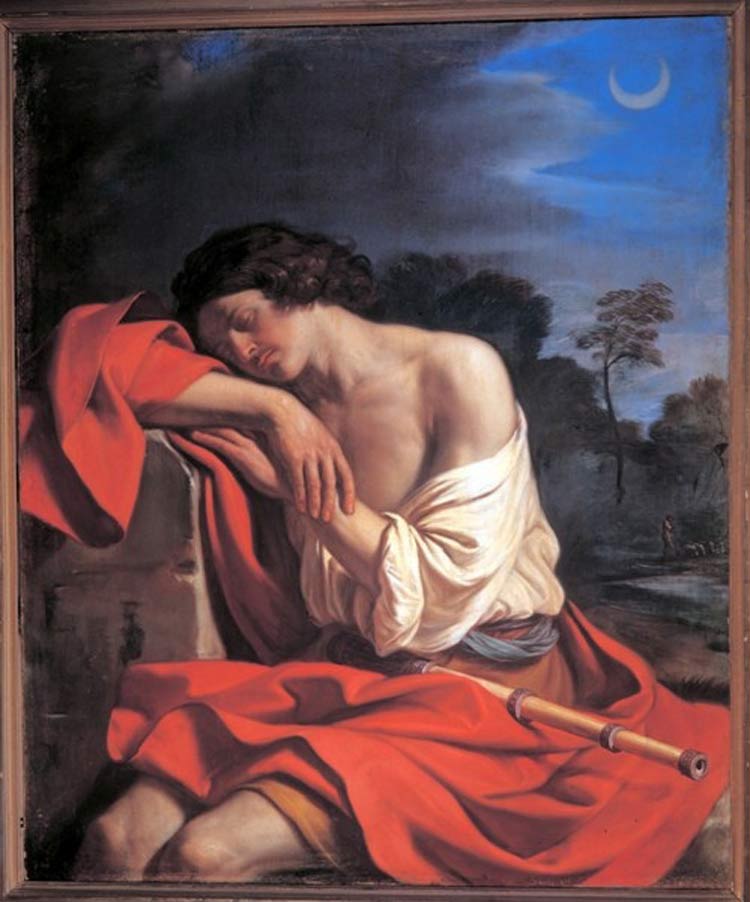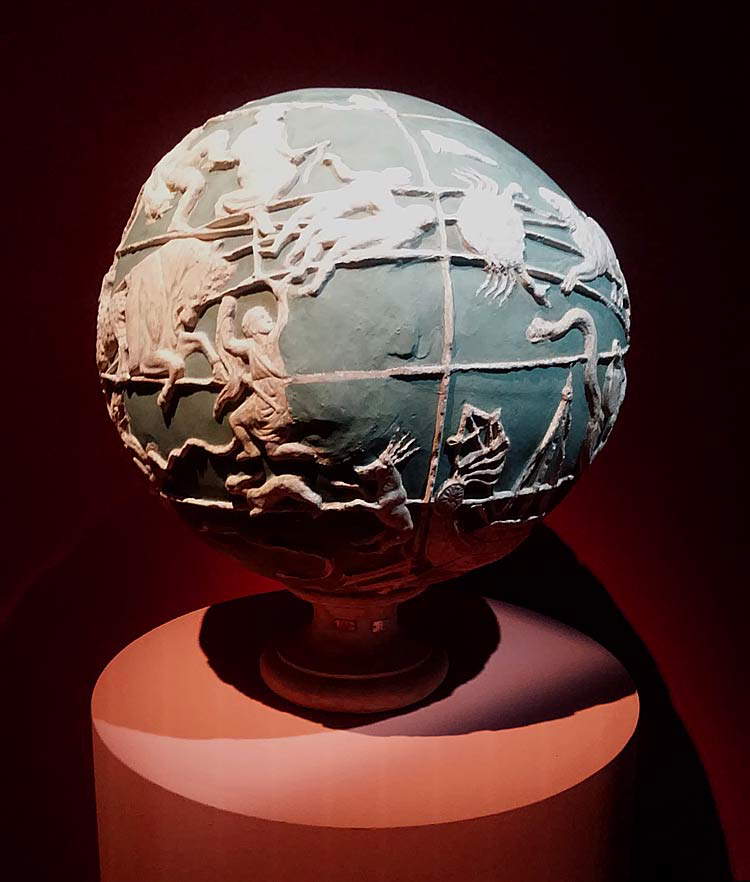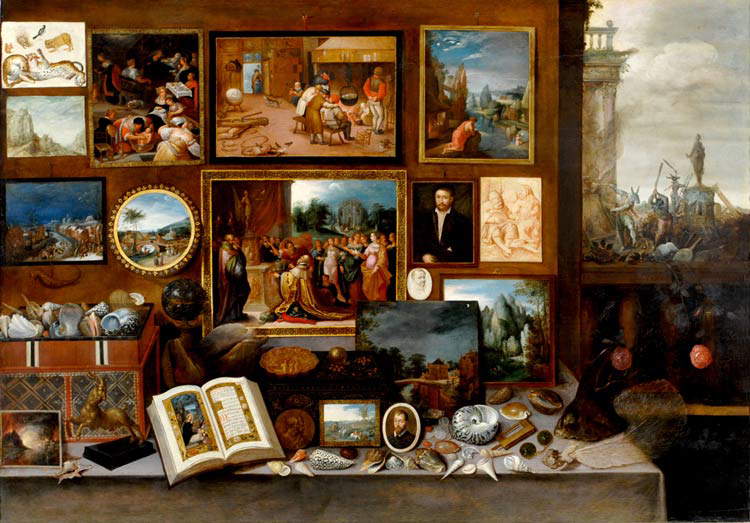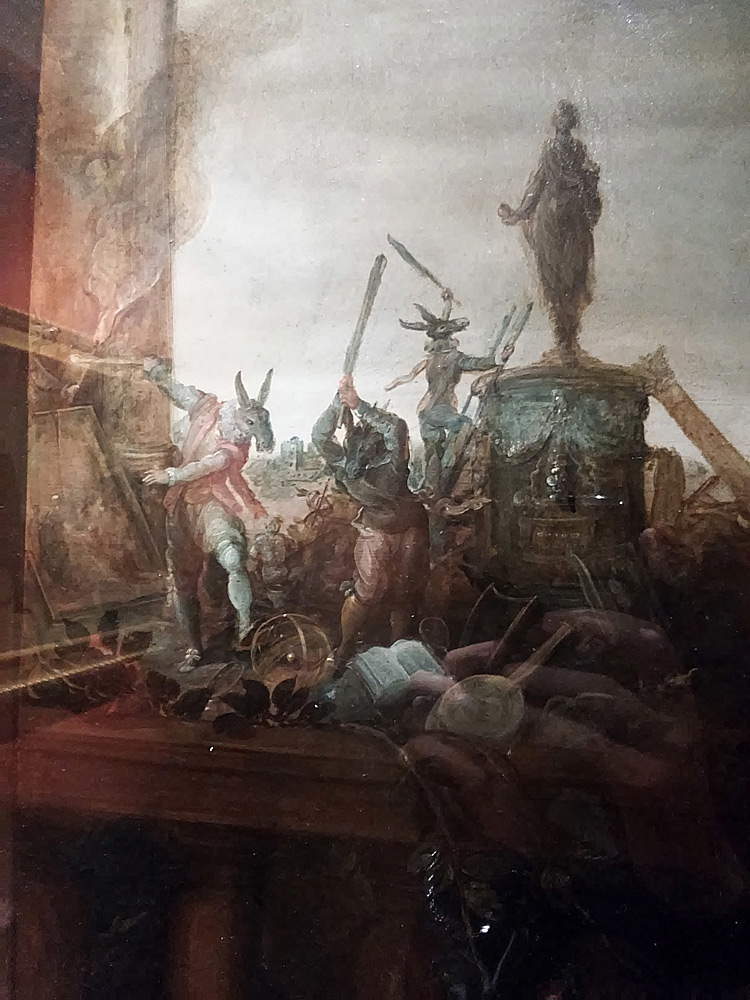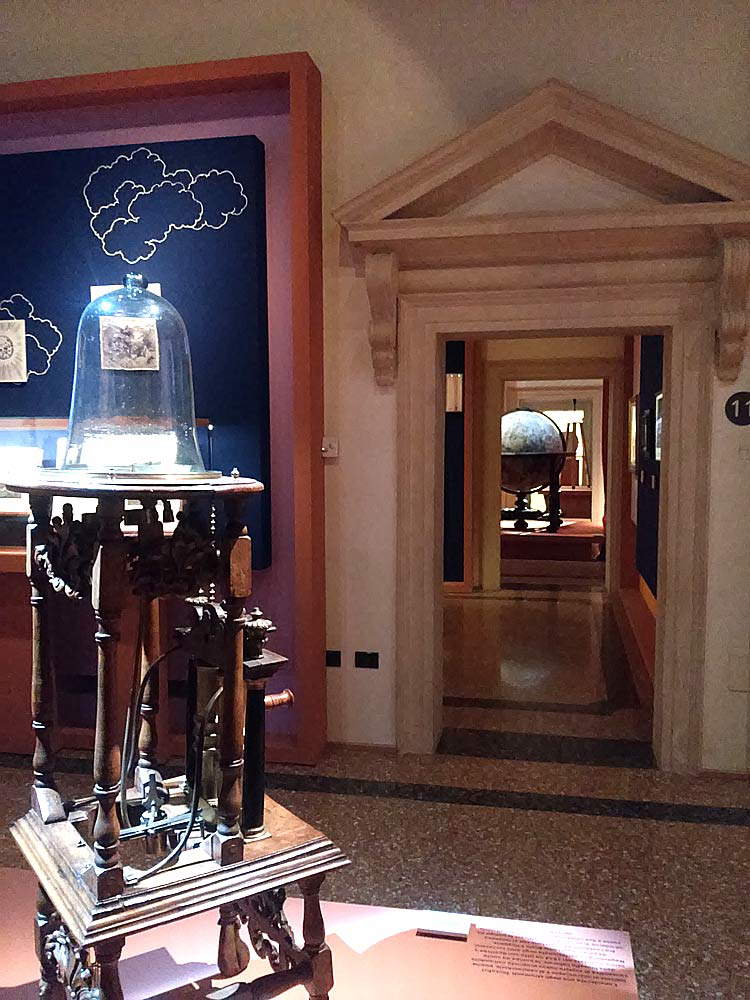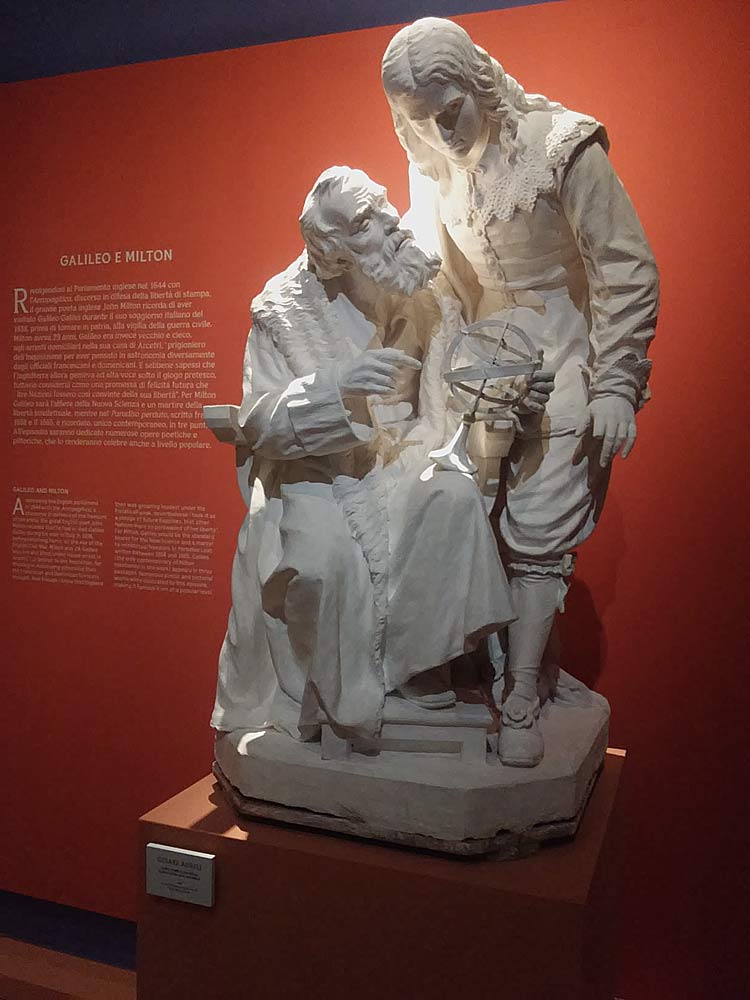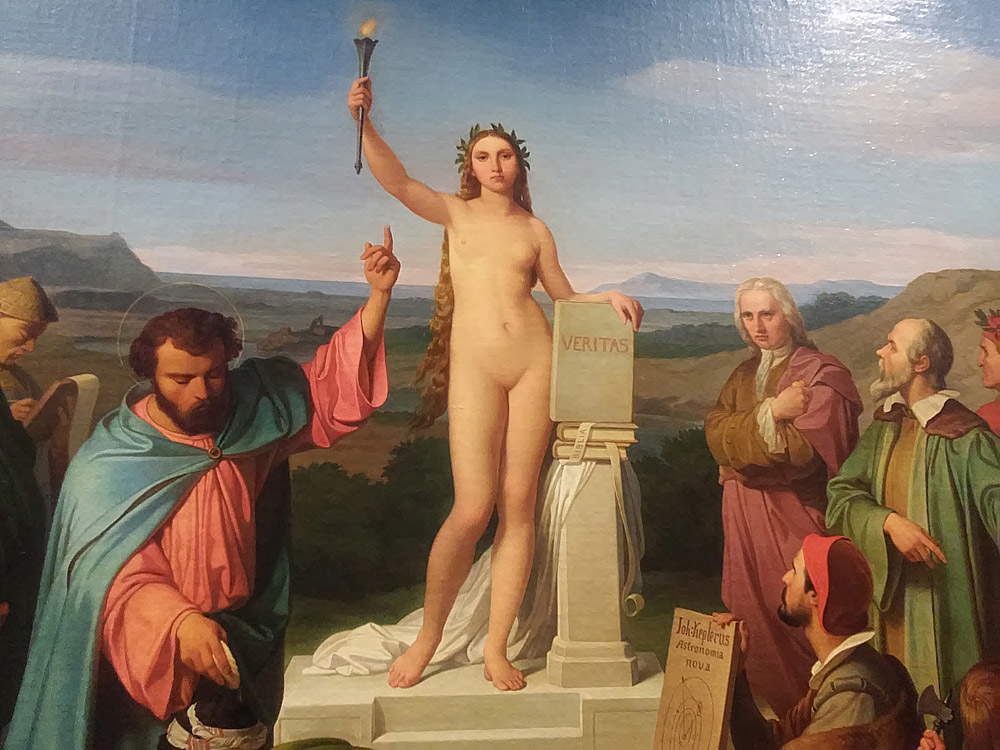by Federico Giannini (Instagram: @federicogiannini1), published on 27/12/2017
Categories: Exhibition reviews
/ Disclaimer
Review of the exhibition 'Galileo Revolution. Art Meets Science' in Padua, Palazzo del Monte di Pietà , through March 18, 2018.
When in 1610 Galileo Galilei (Pisa, 1564 - Arcetri, 1642) left Padua for the coveted Florence to take up the post of “Primary Mathematician and Philosopher of the Grand Duke of Tuscany,” there were not a few in the Venetian city who regretted the great scientist’s choice: his presence in the University of Padua had left indelible marks. “I can well imagine myself to be with my lord Galileo,” one of his greatest friends, Gianfrancesco Sagredo, had written to him, “I can turn over in my memory many of his sweetest reasonings; but how is it possible that imagination should serve me to present to myself and guess so many joyful novelties that in his most kind conversation I used to draw from his living voice? [...] In this head therefore, which is founded above my own interest, the departure of Your Most Excellent Lordship succeeds me of inconsolable et incompensable displeasure.” After all, Galileo had stayed for a good eighteen years in the Veneto, where he had arrived in 1592, the year in which, at the age of twenty-eight, he had succeeded in obtaining the chair of mathematics at the University of Padua: “the best eighteen years of all my age,” he defined them now in old age, in a letter sent in 1640 to Fortunio Liceti. Natural, then, that an exhibition such as Galileo Revolution. Art Meets Science, running until March 18, 2018 at the Palazzo del Monte di Pietà in Padua, would find fertile ground right on the banks of the Bacchiglione River.
It is not difficult to understand why Galileo considered the years he spent in Padua so happy. They were years filled with personal and professional satisfaction since, in the Veneto region, the scientist obtained his first permanent professorship, met friends who remained faithful to him throughout his life (such as the aforementioned Gianfrancesco Sagredo), and whom Galileo used to welcome into his home to give rise to those passionate discussions on science (and more) to which Sagredo himself referred in the passage above, he had the opportunity to work in the intellectually fertile and stimulating environment that we know from the writings of the time and that has been fixed in the collective imagination by the screenplays and film reductions of the life of the Pisan mathematician. An environment that allowed him to carry out his first studies on the telescope (as well as on other scientific instruments that he made in the laboratory that he had set up in his own home) and, consequently, to fine-tune his first astronomical observations, the results of which would later be published in Sidereus Nuncius, the work of 1610 that made his discoveries about the Milky Way, Jupiter’s satellites and the Moon known throughout Europe. Not only that: in Padua, Galileo also had the opportunity to refine his great literary talent, which enabled him to radically renew the form of scientific studies as well.
 |
| A room of the Galileo Revolution exhibition |
 |
| A room from the Galileo Revolution exhibition |
 |
| A room from the Galileo Revolution exhibition |
The exhibition that Padua dedicates to Galileo and his discoveries, focusing for the most part on the period that the scientist spent in the city, aims to evoke the fervent and passionate climate that accompanied him throughout his stay in the Veneto, but there are also other and different points of interest. It can be said that there are basically three main levels of interpretation of the exhibition, curated by Giovanni Carlo Federico Villa and Stefan Weppelmann, and promoted by Fondazione Cassa di Risparmio di Padova e Rovigo together with the University of Padua: three true exhibitions within an exhibition that allow visitors, on one level, to immerse themselves in the life of Galileo Galilei, in his myth and in the contribution he made to the progress of science; on the second, to delve into the emergence of the seventeenth century as the century of the scientific method; and on the third, to see how the echo of seventeenth-century discoveries has spread through subsequent eras, up to the present day. All this makes for an exhibition with an eminently popular slant, conceived and designed (with great intelligence and, we might add, with the sophistication typical of Giovanni Villa’s exhibitions) especially for the general public. Obviously, this is not the first exhibition on Galileo: among several, the splendid review The telescope and the brush that Pisa dedicated to its illustrious scientist in 2009 immediately comes to mind. However, despite the fact that there are many points of contact between this year’s Venetian exhibition and the Tuscan one of eight years ago (there are also many works previously exhibited in Pisa that we find again in Padua), it is necessary to mark the differences: if therefore the exhibition in Palazzo Blu tended more to highlight how scientific discoveries had conditioned the artistic circles of seventeenth-century Italy (one recalls, in particular, a room in which the link between Galileo and his great friend Ludovico Cardi, known as Cigoli, was explored in depth: in Padua, the subject is barely touched upon), that of Palazzo del Monte di Pietà tries to offer a less profound but on the other hand broader perspective, touching on various themes of which we will try to give here a summary and which are linked together by the leitmotif of the figure of Galileo.
After all, it is with him that the story of Galileo Revolution opens, set in pleasantly narrative tones. The first work the visitor encounters is the portrait of Galileo done by Santi di Tito (Florence, 1536 - 1603): it is not the one that helped to fix the artist’s image (if anything, the portrait that Justus Suttermans did when the mathematician was in old age, and which is now in the Uffizi, provided that task), but it is a painting that surprises the observer with its vivid naturalism. “Striking,” writes art historian Federico Tognoni in the catalog, “are the grayish-blue coloring of the eyes, also found in other coeval iconographic evidence of his, the complexion barely brightened by tints of pink at the cheeks and around the eyes, and [...] the short, sparse and particularly reddish hair, which still shows no hint of turning grey.” Galileo, almost forty if one accepts the dating of the painting to 1603, already wears the black toga with white collar, he who as a young man, when he was still a reader at the University of Pisa, had written a Chapter against wearing the toga in order to mock his colleagues embalmed in that mannered academicism against which the ironic pamphlet in tercets was intended to lash out. On the contrary, in Santi di Tito’s portrait, Galileo seems almost proud of the position he achieved with so much sacrifice.
 |
| Santi di Tito, Portrait of Galileo Galilei (c. 1603; oil on canvas, 70 x 61 cm; Grassina, Alberto Bruschi Collection) |
Having introduced the great protagonist, the Paduan exhibition indulges in a couple of rooms to introduce the visitor to the historical context. Summing up the intellectual curiosity that characterized the 17th century is a panel by the Flemish Domenico Remps (c. 1620? - Florence?, c. 1699), the famous Scarabattolo, a sort of glass cabinet that houses a congerie of bizarre objects gathered by a collector: small paintings, skulls, cameos, shells, coral sprigs, pearls, insects, prints, and goldsmith’s objects. The exhibition could not fail to evoke the seventeenth-century use of the Wunderkammern, the “chambers of wonders” in which heirlooms, artifacts and curiosities of the most diverse provenances were collected: not only works of art, but also natural findings and exotic objects that make manifest the desire to investigate and discover that marked an era of enormous changes in science. Changes that went on to radically renew what turned out at the time to be knowledge about the earth, the universe, the stars, the motion of the planets, but also the workings of the human body.
Before the seventeenth century, there was almost no difference between astronomy and astrology: earlier representations of the universe were not based on geometric and mathematical calculations (they would become so after Galileo), but simply relied on experience, and superimposed on the latter the myths and beliefs (for example, those that held that those born at a given time of year, therefore with a particular arrangement of the stars in the sky, were subject to certain influences or character inclinations). Knowledge of the heavens according to the ancient world is represented in the exhibition by the De mundi et sphere declaratione of Hyginus, an astronomer who lived in the first century A.D. and whose work enjoyed a certain fortune in the fifteenth century, so much so that it was printed and accompanied by illustrations (important in that they were the first representations of the constellations published in a printed book). These are, of course, still astrological depictions, connected more to myths than to science, but still capable of exerting great fascination: proof of this are the two celestial maps by Albrecht Dürer (Nuremberg, 1471 - 1528), one dedicated to the northern hemisphere and the other to the southern hemisphere, still linked to the Ptolemaic classification and with the constellations depicted in a style close to those in the printed edition of Hyginus’ treatise. It would take until the multifaceted genius of Leonardo da Vinci (Vinci, 1452 - Amboise, 1519) for a different approach to the study of the heavens: Leonardo focused on the observation of the moon (to which he would have liked to devote a treatise, but the idea never materialized) and arrived, a century before Galileo, not only to delineate with some precision the cycle of lunar phases, but also to explain the phenomenon of ashen light (the effect whereby, before and after the new moon, in addition to the crescent illuminated by the Sun we are able to make out the rest of the lunar disk, illuminated by the light that the Moon receives reflected from the Earth) and to intuit the irregularity of the lunar surface, which was then intended to be smooth and perfect. On display is a drawing in which Leonardo offers a simple but innovative depiction of the Moon, with its oceans, craters, and mountains-that is, the roughnesses that in ancient times were thought to be “spots” that dirtied the image of the Moon, and which many tried to explain by adducing the most imaginative reasons (from unspecified vapors or clouds that would pass through it, to the shadows of the Earth’s mountains).
 |
| Domenico Remps, Scarabattolo o Natura morta a deception (second half of the 17th century; oil on panel, 99 x 137 cm; Florence, Museo dellOpificio delle Pietre Dure) |
 |
| Albrecht Dürer’s two maps |
 |
| Albrecht Dürer, The Northern Hemisphere of the Celestial Globe. Boreal celestial map (1515; woodcut, 420 x 427 mm; Florence, Galleria degli Uffizi, Gabinetto dei Disegni e delle Stampe) |
 |
| Albrecht Dürer, The Southern Hemisphere of the Celestial Globe. Southern celestial map (1515; woodcut, 421 x 432 mm; Florence, Galleria degli Uffizi, Gabinetto dei Disegni e delle Stampe) |
 |
| Leonardo da Vinci, Variation of the Figure of the Moon in its Phases (1505-1508; pen and ink, 59.6 x 44.4 cm; Milan, Veneranda Biblioteca Ambrosiana) |
 |
| Leonardo da Vinci, Two drawings of the face of the Moon, discourse on the refraction of the sun’s rays on the water, detail (1505-1508; pen and ink, 59.6 x 44.4 cm; Milan, Veneranda Biblioteca Ambrosiana) |
The slow progress toward Galilean achievements finds two important chapters in the figures of Tycho Brahe (Knutstorp, 1546 Prague, 1601) and Johannes Kepler (Johannes von Kepler, Weil der Stadt, 1571 - Regensburg, 1630). The former’s studies, which made use of innovative and modern planetary models that the Danish astronomer also elaborated with the help of numerous instruments(primarily armillary spheres, i.e., models of the sky formed by rings that represented the orbits of the planets: the exhibition displays several of them), formed the basis for the discoveries of the latter, who tried in vain to persuade his colleague to embrace the heliocentric theories (in fact, Brahe remained convinced that it was the Sun that revolved around the Earth): in return, Kepler was successful in identifying theelliptical orbit of the planets and managed to maintain cordial relations with Galileo Galilei. Too bad the relationship between Galileo and Kepler is not touched upon in the exhibition and is barely mentioned in the catalog: in fact, the German astronomer was among the first to congratulate his Pisan colleague following the publication in 1610 of Sidereus Nuncius, the epoch-making treatise with which Galileo, as anticipated in the opening, announced to the world the discovery of Jupiter’s Medicean satellites, the true nature of the Milky Way as well as the roughness that characterizes the lunar surface, and the origin of the light emanating from the Moon (it was astounding at the time to discover that in fact the Moon merely reflected the light of the Sun). In addition to displaying the first edition of the work (in a print with handwritten annotations), the Padua exhibition shows the viewer precious watercolor drawings from 1609 with observations of the phases of the Moon made between November and December of that year. Drawings that also demonstrate the artistic talent of Galileo, who would have gladly been a painter had he not taken the path of science, drawings that, writes Franco Giudice in the catalog, “are striking both for their realistic appearance and for the way they manage to render the plasticity of the lunar surface,” and drawings that were made “live,” while Galileo was observing the satellite with his telescope, an instrument to the perfection of which, as is well known, the scientist contributed substantially.
Needless to say, Galileo’s astronomical discoveries eventually endeared themselves to the imaginations of artists, who on the one hand took to depicting the heavens according to scientific dictates, and on the other hand labored to sing the praises of astronomy: Galileo’s Revolution offers visitors examples of both strands. Among the noteworthy works that the public encounters following an itinerary that starts from ancient art and which has been largely overlooked here, it is necessary first of all to give an account of a pair of paintings that were commissioned from Guercino (Giovanni Francesco Barbieri, Cento, 1591 - Bologna, 1666) by Cardinal Lorenzo de’ Medici:Atlas andEndymion, painted in 1646 and 1647 respectively. In the first canvas, which depicts the mythological giant forced by Zeus, as a punishment, to bear the weight of the entire universe on his shoulders, the arrangement of the stars in the celestial vault is random and does not reflect any scientific order: interesting, in this sense, is the parallel that the curator has established with the sphere of theFarnese Atlas of the second century AD, where we observe the sky represented according to Ptolemy’s theories and of which Rivoluzione Galileo exhibits the plaster cast of 1930. The situation changes withEndymion: the shepherd loved by Artemis, goddess of the moon, is depicted asleep as per iconography, but with a telescope resting on his knees, similar to those Galileo used to use for his observations. One wished to read this detail as a direct homage to the scientist, who had then been dead for five years: the overlap between the figure of Endymion and that of Galileo, moreover, had already been advanced in literature, with Giambattista Marino who, in his Adonis, had put in the mouth of the protagonist (Adonis, precisely) a praise of Galileo, who was called a “novello Endimione.” “Tu solo osservator dogni suo moto [of the moon, nda], / e di qualunque ha in lei parte nascosta, / potrai, senza che vel nulla ne chiuda, / novello Endimion, mirarla ignuda.”
Equally celebratory is a work such as the Astronomers by Niccolò Tornioli (Siena, 1598 - Rome, 1651), a complex allegory whose meaning, however, remains to be identified with certainty, but which nevertheless “is certainly affected by the debate that developed around the Galilean question, which was alive even after the scientist’s death in 1642” (thus Annalisa Pezzo in the catalog): in Tornioli’s painting, too, the protagonist is the telescope, used by a young man who uses it to observe a globe instead of the sky (a detail that would perhaps make such a figure a personification of optics) and who is surrounded by figures from various historical periods, evidently engaged in a discussion of astronomy. Instead, to find truthful representations of the stars, we must turn our gaze to the so-called Astronomical Observations by Donato Creti (Cremona, 1671 - Bologna, 1749), a series of eight canvases designed with the purpose of representing the solar system as it was known at the time, all of equal size and all painted in 1711 by the Lombard artist for the Bolognese nobleman Luigi Marsili, who wanted to give them to Pope Clement XI “to entice His Holiness to a specola,” that is, to spur him to build an astronomical observatory.
 |
| Galileo Galilei, Astronomy. Observations of Lunar Phases, November-December 1609 (1609; autograph paper manuscript, watercolor drawings on paper, 33 x 23 x 1.7 cm; Florence, Biblioteca Nazionale Centrale, ms. Galileiano 48 |
 |
| Two paintings by Guercino: on the left lAtlas, on the right lEndimione |
 |
| Guercino, Atlas (1646; oil on canvas, 126 x 101 cm; Florence, Museo Bardini) |
 |
| Guercino, Endymion (1647; oil on canvas, 125 x 105 cm; Rome, Galleria Doria Pamphili) |
 |
| Cast of the sphere of theFarnese Atlas (c. 1930; alabastrine plaster, diameter 65 cm, height 75 cm; Rome, Museo della Civiltà Romana) |
 |
| Niccolò Tornioli, The Astronomers (1645; oil on canvas, 148 x 218.5 cm; Rome, Galleria Spada) |
 |
| Donato Creti’s paintings of astronomical observations (Rome, Vatican City, Pinacoteca Vaticana) |
 |
| Donato Creti, Astronomical Obs ervations. Jupiter (1711; oil on canvas, 51 x 35 cm; Rome, Vatican City, Pinacoteca Vaticana) |
A key junction of the exhibition is the Dialogo sopra i massimi sistemi of 1632, the work with which Galileo intended to offer a kind of summary of all his discoveries, but which actually cost him a conviction for heresy: a conviction that, as is well known, forced the scientist toabjure in order to avoid far worse consequences. The exhibition avoids going into the details of the relationship between Galileo and the Church (it limits itself to reporting that the condemnation was also the product of internal dissensions within the Church and of the lively concern about a possible weakening of ecclesiastical authority that the free circulation of Galilean ideas would have entailed, all the more dangerous in an era of strong religious clashes): in the continuation, the review focuses largely on the effects that the affair provoked. On the one hand, the scientific community did not lose heart and the progress of knowledge advanced without halting: examples of this are the splendid pastels by the German astronomer Maria Clara Eimmart (Nuremberg, 1676 - 1707), best known for the substantial body of drawings of celestial phenomena she produced in the late 17th century. On the other, Galileo’s discoveries were subjected to ecclesiastical censure: symbolizing the attitude of the religious authorities is a painting by Frans Francken II (Antwerp, 1581 - 1642), in which a scene with iconoclastic donkeys raging against scientific instruments is depicted alongside a collector’s cabinet. Note how the painting, thanks to a subtle scenographic device devised by the curator, is placed in axis with the instruments displayed in the preceding rooms: by turning your back to the painting you can see them all in succession.
Finally, the condemnation of the Pisan scientist produced an additional effect: the construction of the Galileo myth. The entire finale of the exhibition is dedicated to this theme, with paintings and sculptures that, from the 19th century onward, traced the entire biographical story of the great mathematician and astronomer: from the painting by Cristiano Banti (Santa Croce sull’Arno, 1824 - Montemurlo, 1904) depicting him before theInquisition, to the sculpture by Cesare Aureli (Rome, 1843 - 1923) aimed at immortalizing the visit that the great English poet John Milton made to Galileo during his Italian sojourn in 1638, through Luigi Mussini ’s (Berlin, 1813 - Siena, 1888) Triumph of Truth, a work in which Truth, at its center, illuminates a series of historical figures, including Galileo himself, clad in a green toga and caught pointing to the book held by Copernicus.
 |
| Galileo Galilei, Dialogo sopra i massimi sistemi (1632; printed work with handwritten autograph notes, 18.5 x 24.5 x 5.5 cm; Padua, Biblioteca antica del seminario vescovile) |
 |
| Maria Clara Eimmart, Aspect of Saturn (late 17th century; pastel on blue cardboard, 64 x 52 cm; Bologna, University of Bologna, Museo della Specola) |
 |
| Frans Francken II, Cabinet of an Amateur with Iconoclastic Don keys (oil on panel, 106 x 148 cm; Chiavari, Economic Society of Chiavari) |
 |
| Detail of the iconoclastic donkeys |
 |
| The scientific instruments visible when leaving Frans Francken’s painting behind |
 |
| Cristiano Banti, Galileo before the Inquisition (1857; oil on canvas, 110 x 140 cm; Carpi, Palazzo Foresti Collection) |
 |
| Cesare Aureli, Galileo Galilei and John Milton (1900; plaster sketch, 60 x 60 x 120 cm; Trevi, Museo Civico) |
 |
| Luigi Mussini, The Triumph of Truth, detail (1847; oil on canvas, 143.5 x 213 cm; Milan, Accademia di Belle Arti di Brera) |
It is difficult to fully summarize the reflections that the exhibition aims to animate: no mention has been made, for example, of the works of contemporary artists, as well as those of the ancients who grappled with the theme of astrological myths (Rubens’ Milky Way coming from the Prado is not to be missed), the discourse on solar observations and the investigation of the relationship between Galileo and music has been left out (and an entire essay in the catalog is dedicated to this relationship), there has been no mention of how the exhibition proposes to broaden its scope by involving various art forms, including cinema and comics. The scale of the exhibition in Padua, certainly one of the largest in Italy this year, calls for a visit in person to better grasp the curators’ insights. Not least for the fact that, among the strengths of Rivoluzione Galileo, it is necessary to record the effectiveness of the installations, designed to dialogue respectfully with the rooms of Palazzo del Monte di Pietà, and at the same time to give the exhibition a soul that characterizes it, even indulging in some passages with a high scenic impact (just look at the room in which the theme of lunar observations is explored, here in the first photograph included in this article) and keeping all the rooms set on the motif of large colored frames leaning against the walls, within which the objects and works on display were arranged.
Rivoluzione Galileo is, in good substance, an excellent exhibition of popularization, strengthened by an itinerary that finds its originality precisely in the coexistence of various levels of investigation followed by different narrative registers that make the narrative range from Guercino to Anish Kapoor, from Georges Méliès to Tintin, from Gaetano Previati to Caparezza, without forgetting the precious first editions of Galileo’s works and his handwritten notes. And the visitor is left free to orient himself according to his own sensibility within (and of course beyond) the confines of a journey that spans four centuries of history and is all aimed at the future. Add to this the possibility of leaving Palazzo del Monte di Pietà and going, with just a few steps, to visit the places that Galileo himself lived and frequented.
Warning: the translation into English of the original Italian article was created using automatic tools.
We undertake to review all articles, but we do not guarantee the total absence of inaccuracies in the translation due to the program. You can
find the original by clicking on the ITA button. If you find any mistake,please contact us.

